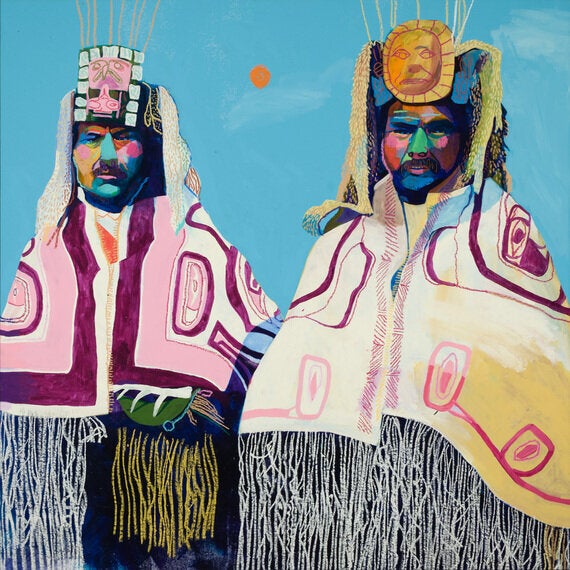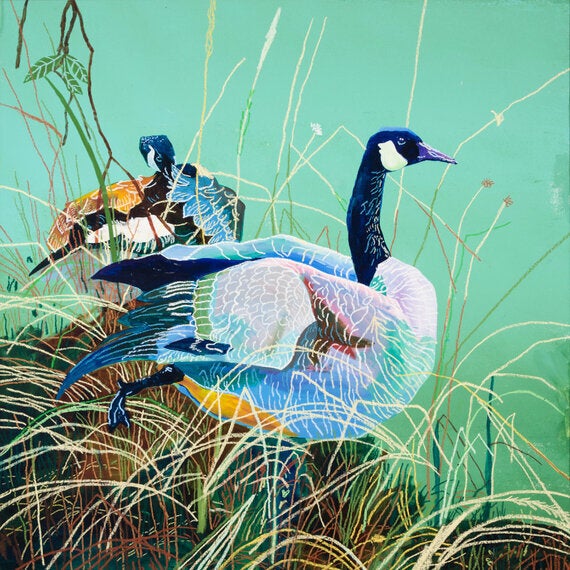Andy Dixon is creatively multi-talented. Before achieving success as a visual artist, he pursued an impressive career in music, playing in punk-rock band d.b.s. and composing electronic music as Secret Mommy. Though his work is appreciated internationally, Dixon is currently based in Vancouver, where he focuses on his colorful multimedia paintings. I caught up with Dixon to talk about his new solo show Canadiana, which opened May 14 at Initial Gallery.

Haida Men, Andy Dixon, 2015. 49" x 49" mixed media.
To start off, can you summarize Canadiana briefly -- the subject matter, the style?
Well, there's plenty of reference points to Canadian culture and also Canadian art history, done in the style that I have been working in for a long time. Some people call it New Fauvism -- lots of bright colours and stuff.
I checked out your previous work, and while your style's very consistent, this seems like pretty new material for you, content-wise. How do you see and position this particular show in relation to your existing body of work?
I can see why it would seem different, but at the same time, I think there are definite similarities to my entire body of work over the last several years, which often uses allusions to my predecessors, in something I call the "great conversation." That's a way to align myself with art history, and make reference to where we've come from. Essentially, it's a way to connect modern art with art in the past. In this case, the allusions I'm using, or most of them, are allusions to Canadian art, which is something I've never really done before. So in that way it's only a slight variation, but it does look quite different.
Another thing that probably makes it look a bit different is that I normally use images of luxury and opulence, and Canadian history just doesn't have that much of that! It's a pretty modest country in a lot of ways, so it was tough to find some images that connect to that. There are some -- there's some exploration of the fur coat and things like that, but not too much. So in some ways this show's subject matter is a bit different, but I don't see it as being too vast of a departure.
That makes a lot of sense. Looking back at your career, you've been a working artist for a long time. It looks like you've had a fairly international career -- you've shown in London, you've lived in New York. Did that inform your decision to focus on Canadian subject matter for this show?
Absolutely. The international success, if you want to call it that, is quite new. Just in the last few years I've started working with galleries in London and New York and Austin. The gallery in London does a lot of art fairs, in Paris and places like that, and it kind of got me thinking about my relationship to Canada and Canadian art. That's something I might not have thought of had that not happened.

Canadian Geese, Andy Dixon, 2015. 49" x 49" mixed media.
From talking to you I can hear that you're very interested in and connected to art history. So, I was wondering who are a few of your greatest influences, both contemporary and historical?
Matisse is a huge one. He's my guy, for sure. Jean-Michel Basquiat, has also been a big one. When I was a punk kid he was one of the first artists that I cared about. There was probably a period in my life where I was kind of anti-fine art, because I was too punk for it, and I thought it was...I don't know.
Could you give a description of the materials and techniques that you used for this show?
So the technique is the one I always use, which is both house paint and acrylic. I work on unstretched canvas that's rolled out, usually on the floor, and I apply the layers of paint and try to get it as thin and even as possible because later, I go in and draw with oil pastel on top. If the surface isn't flat, you won't get a nice mark on it. That's also why I work on unstretched canvas -- because I need the surface behind the canvas to be flat. If it's stretched, then when you try to draw on it you're kind of pushing against the canvas, pushing it in and you can see the beams behind it and whatnot. Another thing I like about this process is that I get one more compositional edit, because when I'm done, I'll tape it off however I want and get a stretcher made for that size. Composition is actually one of the last things that's decided. Often the painting was 25 to 30 per cent bigger than you actually see, because I've edited it down.

Group of Seven, Andy Dixon, 2015. 89" x 59", mixed media.
That's a very unique process!
Yeah, again, despite me bad-mouthing punk culture, I actually take a lot from it, and one of the things I've kept is that DIY way of expressing yourself. Sometimes the tools that you use aren't necessarily professional, and that ends up becoming part of the whole ethos around it.
Like, for instance, if you're in a punk band, you're often using cheap gear but actually, that cheap gear ends up becoming part of the sound, because it has this distortion to it that was maybe unintended, but become an essential part of the style. Part of the punk ethos is that whole idea of DIY. That part sticks with me, and that house paint, to me, feels like the equivalent of a bad amplifier.
It seems like there's a lot of contradictions in your work, in a way.
Yeah, I definitely consider it a paradox, for sure.
Canadiana is showing at Initial Gallery, 2339 Granville Street, until June 13.
ALSO ON HUFFPOST:
